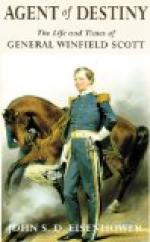commission as Captain in the
U.S. army; recruits his company and embarks for New Orleans, 7;
arrested and tried by court-martial for words spoken of General
Wilkinson, 8; tenders his resignation, 8; finding of the court, 9;
letter to Lewis Edwards, 10; rejoins the army at Baton Rouge, La.;
embarks for Washington; vessel gets aground, 11; appointed Colonel;
visits the Secretary of War with General Hampton; an unpleasant
incident, 12; war with Great Britain; ordered to the Niagara
frontier, 13; volunteers to cross the Niagara; marches to Lewiston,
16; the attack on Fort George, 17; a flag of truce, 18; a prisoner,
and attacked by Indians; embarks for Boston, 19; addresses Irish
prisoners; letter to Secretary of War, 20; selects hostages in
retaliation for Irish prisoners, 21; returns to Washington, 22;
ordered to Philadelphia; appointed Adjutant General; promoted
Colonel of his regiment; joins General Dearborn, and appointed chief
of staff, 23; assault on Fort George; Scott leads the advance, 24;
struck by a piece of timber and collar bone broken, 25; anecdote of
a British officer, 26; resigns the office of Adjutant General, 27;
joins General Wilkinson, 28; marches for Sackett’s Harbor; appointed
to command of a battalion; preparing new levies of troops, 29;
appointed Brigadier General; ordered to join General Jacob Brown;
establishes camp of instruction at Sackett’s Harbor; assigned to a
new command; moves toward Chippewa, 30; wins the battle of Chippewa;
report of General Brown, 32; moves to mouth of the Niagara, 33;
battle of Lundy’s Lane, 34, 35; General Scott disabled, 37-39; in
command for defense of Philadelphia and Baltimore, 39; reception at
Princeton; declined to act as Secretary of War; ordered to Europe,
40; receives attention in Europe; return home; headquarters in New
York; married to Miss Mayo, of Richmond; names of his children, 41;
Congress passes resolutions complimenting him; present at the death
of President Monroe; thanked by Legislatures of Virginia and New
York; honorary member of the Society of the Cincinnati; order of
General Jackson, 42; letter of General Jackson to General Scott; his
reply, 43; letter to General Jackson, 44; General Jackson’s reply;
Scott calls on General Jackson, 45; tribute to General Jackson; his
work on general regulations for the army, 46; president of board of
army and militia officers; publication of his work on infantry
tactics; the temperance reform; his views on, 47; controversy with
General Gaines; tenders his resignation; not accepted, 48; letter to
Secretary of War; the Secretary’s reply, 49; assigned to command of
Eastern Department; treaty with Sac Indians, 50; ordered to
Illinois; Asiatic cholera, 53; letter to Governor Reynolds, 54;
newspaper extracts in regard to General
U.S. army; recruits his company and embarks for New Orleans, 7;
arrested and tried by court-martial for words spoken of General
Wilkinson, 8; tenders his resignation, 8; finding of the court, 9;
letter to Lewis Edwards, 10; rejoins the army at Baton Rouge, La.;
embarks for Washington; vessel gets aground, 11; appointed Colonel;
visits the Secretary of War with General Hampton; an unpleasant
incident, 12; war with Great Britain; ordered to the Niagara
frontier, 13; volunteers to cross the Niagara; marches to Lewiston,
16; the attack on Fort George, 17; a flag of truce, 18; a prisoner,
and attacked by Indians; embarks for Boston, 19; addresses Irish
prisoners; letter to Secretary of War, 20; selects hostages in
retaliation for Irish prisoners, 21; returns to Washington, 22;
ordered to Philadelphia; appointed Adjutant General; promoted
Colonel of his regiment; joins General Dearborn, and appointed chief
of staff, 23; assault on Fort George; Scott leads the advance, 24;
struck by a piece of timber and collar bone broken, 25; anecdote of
a British officer, 26; resigns the office of Adjutant General, 27;
joins General Wilkinson, 28; marches for Sackett’s Harbor; appointed
to command of a battalion; preparing new levies of troops, 29;
appointed Brigadier General; ordered to join General Jacob Brown;
establishes camp of instruction at Sackett’s Harbor; assigned to a
new command; moves toward Chippewa, 30; wins the battle of Chippewa;
report of General Brown, 32; moves to mouth of the Niagara, 33;
battle of Lundy’s Lane, 34, 35; General Scott disabled, 37-39; in
command for defense of Philadelphia and Baltimore, 39; reception at
Princeton; declined to act as Secretary of War; ordered to Europe,
40; receives attention in Europe; return home; headquarters in New
York; married to Miss Mayo, of Richmond; names of his children, 41;
Congress passes resolutions complimenting him; present at the death
of President Monroe; thanked by Legislatures of Virginia and New
York; honorary member of the Society of the Cincinnati; order of
General Jackson, 42; letter of General Jackson to General Scott; his
reply, 43; letter to General Jackson, 44; General Jackson’s reply;
Scott calls on General Jackson, 45; tribute to General Jackson; his
work on general regulations for the army, 46; president of board of
army and militia officers; publication of his work on infantry
tactics; the temperance reform; his views on, 47; controversy with
General Gaines; tenders his resignation; not accepted, 48; letter to
Secretary of War; the Secretary’s reply, 49; assigned to command of
Eastern Department; treaty with Sac Indians, 50; ordered to
Illinois; Asiatic cholera, 53; letter to Governor Reynolds, 54;
newspaper extracts in regard to General




